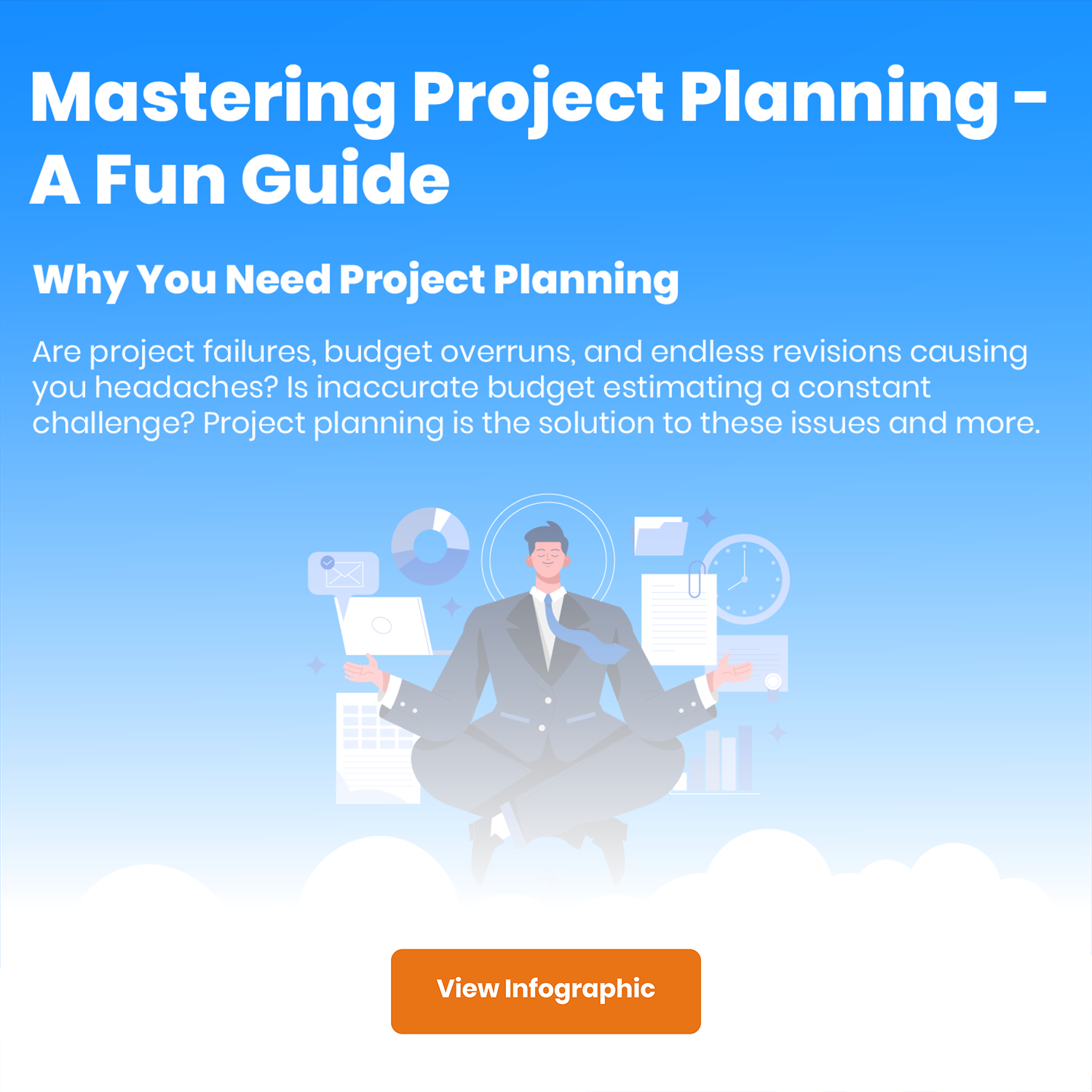
Are your projects often failing? Are you constantly creating new plans after spending months on a project? Or do you struggle to correctly create a budget estimate for your projects? If these issues seem familiar, then you would want to learn more about project planning.
Understanding the components of project planning, correctly executing project planning steps, and finding the right tools with the necessary features will be a game-changer for you.
Before getting into the nuances of project planning, let’s first understand what it means.
What is Project Planning?
This can be defined as a strategic project planning process of outlining and organizing the necessary steps to achieve project objectives. In simple terms, project management planning helps you create a roadmap for your project. It helps you figure out what needs to be done, how you will do it, and how you keep everything on track. You start by defining your goals and breaking down the work into manageable tasks. Then, you estimate how much time and resources each task will require.
You also need to anticipate potential risks and establish ways to communicate and stay in control. And once the project is in motion, you’ll set up systems to monitor progress, manage any changes, and ensure you’re sticking to your project constraints.
Types of Project Planning
Explore the diverse paths of project planning with vertical, horizontal, and joint approaches to achieve project success.
1. Vertical Planning (Waterfall Planning): Vertical planning, also called waterfall planning, involves sequentially organizing the project’s phases, starting from the beginning and progressing step by step.
2. Horizontal Planning (Agile Planning): Horizontal planning, also known as agile planning, entails simultaneously planning different aspects or parts of the project. This approach allows for flexibility and adaptability.
3. Joint Planning (Integrated Planning): Joint planning, sometimes termed integrated planning, combines elements of both vertical and horizontal planning. Some project parts are planned sequentially, while others are planned concurrently. This method integrates structured and flexible planning approaches.
Why is project planning important?
We can infer from the project planning definition that it provides a solid foundation for successful project execution. Now let’s go in-depth to understand the importance of project planning!

Gives Direction
Project planning sets clear objectives and gives everyone on the team a direction towards which they have to work. It’s like having a roadmap that lays out the project’s scope, deliverables, and milestones from beginning to end. This way, you stay on track and make sure your project is in line with the overall organizational goals.
Helps in Project Management Resource Planning
When you plan your projects effectively, you are able to make the most out of your resources. You figure out ahead of time the people, equipment, and materials you will need so you don’t run into any shortages or end up with too much of something. This way, you make sure you have the right resources when you need them, which helps you avoid delays and get the most productivity out of your team.
Mitigates Risks
When you plan your projects, you have to think about all the things that could go wrong and devise ways to handle them. You do risk assessments to spot potential challenges ahead of time and come up with backup plans. This way, when unexpected stuff happens, it doesn’t throw you off completely. It helps you make better decisions and keeps your project tough and resilient.
Manages Time & Cost
While planning projects, you are able to set up timelines and budgets that actually make sense. You break down the project plan into the smaller tasks, estimate how long each one will take, and assign the right resources. This way, you can keep an eye on how things are going and catch any potential delays or cost overruns before they become a big problem. It helps you make adjustments and take action quickly so you finish your projects on time and within budget.
Keeps Stakeholders Aligned
Project planning keeps all the important people on board. You involve key stakeholders in the planning process, so you can all be on the same page. It’s all about talking and keeping everyone in the loop about the project goals, what you expect, and how things are going. By setting up regular communication and reporting systems from the get-go, you manage stakeholder expectations, keep things transparent, and work together as a team.
What are the Components of Project Planning?
Now that you have seen what planning projects can do for you let’s see the three important components or elements of project planning.
Scope
The scope of the project basically talks about what you will do and what you will not do. It’s all about figuring out the specific things you will deliver, the features you will have, and how everything will work. By nailing down the scope, you ensure that everyone involved knows what’s included and what’s not. This way, you avoid scope creep, which is when things get added on and go off track. You would definitely not want that because it leads to delays and budget problems.
Budget
When planning a project, you have to figure out how much money you will need and where it will be used. You estimate all the costs, like how much you will spend on labor, materials, equipment, and all those other expenses that come with getting things done. Budget planning is important because it helps you know how much the whole project will cost and ensure you have enough cash to cover it. Plus, it lets you keep an eye on your spending and make sure you stay within the budget you set.
Timeline
When creating a project plan, you have to map out a schedule that tells you when things are going to happen. You figure out the start and end dates for all the tasks and milestones. You also look at how long each task will take, what tasks depend on others, and the order they have to be done. This timeline planning is key because it helps you manage your resources and efficiently coordinate tasks.
You can spot the critical paths that could slow us down and mark your big milestones. By setting up realistic timelines that you can actually achieve, you can keep an eye on how you are doing, catch any potential delays, and take action to keep things on track.
Also Read: 5 Phases of Project Management
7 Simple Steps to Create a Successful Project Plan
Creating a project plan is essential to keep your project on track and make sure it succeeds. Here are seven steps to help you create a complete project plan:
Step 1: Define Your Project’s Goals: Start by clearly stating what your project is all about, what you want to achieve, and what you’ll deliver. Make sure everyone involved understands this.
Step 2: Identify Everyone Involved: Figure out who’s part of your project team, who the clients are, who’s sponsoring it, and who will use the end product. Understand their roles and expectations to communicate and work together effectively.
Step 3: Set a Timeline: Make a realistic schedule with specific start and end dates for each part of your project. Think about which tasks depend on others and make sure you have enough time for everything. Tools like Gantt charts can help you see the schedule visually.
Step 4: Break It Down: Divide your project into smaller tasks and sub-tasks. Organize them in a list to assign responsibilities and track progress easily.
Step 5: Get the Resources You Need: Determine what you’ll need for each task, like people, equipment, and materials. Make sure you have what you need when you need it to avoid delays.
Step 6: Deal with Risks: Identify potential problems that might come up during your project. Make a plan to handle these issues and be ready with backup plans if they happen. Keep reviewing and updating your risk plan throughout your project.
Step 7: Keep Everyone in the Loop: Set up a way to share project updates with everyone involved. Decide how and when you’ll report progress through updates or meetings.
Remember, your project plan can change as your project moves forward. Keep an eye on it, make adjustments when needed, and make sure your project stays on the path to success.
Examples of Project Planning
Project planning is the process of outlining the steps needed to complete a project successfully. It involves defining the project goals, identifying tasks, creating a timeline, assigning resources, and establishing a communication plan.
Here are some examples of project planning in different fields:
- Software Development: In software development, project planning typically involves creating a work breakdown structure (WBS), which is a hierarchical outline of the project deliverables. The WBS is then used to create a project schedule, which outlines the timeline for completing each task.
- Construction: In construction, project planning typically involves creating a Gantt chart, which is a type of bar chart that illustrates the project schedule. The Gantt chart shows the start and end dates of each task, as well as the dependencies between tasks.
- Marketing: In marketing, project planning typically involves creating a marketing plan, which outlines the marketing goals, target audience, marketing strategies, and marketing budget. The marketing plan is then used to create a marketing calendar, which outlines the timeline for executing the marketing strategies.
These are just a few examples of project planning. The specific steps involved in project planning will vary depending on the size and complexity of the project. However, the basic principles of project planning are the same: define the project goals, identify tasks, create a timeline, assign resources, and establish a communication plan.
Tools for Project Planning and Management
Effective project management is essential in today’s fast-paced business environment, and several tools have emerged to streamline the process. Here, we explore these project management tools, each offering unique features and capabilities to suit various project management needs.
Quixy: A no-code Quixy simplifies project management with BPM innovation and user-friendly workflows.
Trello: Trello, known for its Kanban-based approach, streamlines project tasks efficiently.
Monday.com: Monday.com offers versatile dashboards, automation, and pre-built templates for seamless project management.
Wrike: Wrike prioritizes communication and transparency with real-time analytics for performance insights.
Asana: Asana is a feature-rich solution that emphasizes strategic goal-setting and workflow visualization.
Notion: Notion is ideal for small teams, offering customizable project planning tools and collaboration features.
Microsoft Project & Portfolio Management: Microsoft Project excels in single project management with budget tracking and interactive dashboards.
Choosing the right project management tool is crucial for your team’s success. Whether you need simplicity, flexibility, or comprehensive features, these tools offer various solutions to help you manage projects efficiently in today’s dynamic business landscape.
Also Read: Supercharge Project Management with No-Code Apps

Also Read: Project Management Hacks 101
Streamline Your Workflow with No-Code Tools and Efficient Project Planning
No-code tools and project planning make a perfect duo, combining the strengths of simplicity and efficiency. No-code tools empower individuals without extensive coding knowledge to create sophisticated applications and workflows effortlessly. These intuitive platforms provide a visual interface that enables users to drag and drop elements, configure logic, and automate processes without writing a single line of code.
By integrating project planning into this equation, teams can seamlessly map out tasks, allocate resources, set timelines, and collaborate effectively. This combination streamlines the development process, ensuring efficient project management while eliminating the need for complex coding. With no-code tools and project planning working hand in hand, individuals and teams can unleash their creativity and productivity, delivering innovative solutions without the traditional barriers of programming expertise.
Quixy’s End-to-End Solution from Project Planning to Management
Quixy can be your end-to-end project planning and management tool because of its unique combination of features:
- No-code application building: With Quixy’s drag-and-drop interface, you don’t need coding expertise to build custom project management applications. You can tailor the tool to fit your specific project needs and workflows.
- Pre-built project management apps: Quixy offers pre-built applications for common project tasks like creating tasks, assigning them to team members, and tracking progress. This saves you time from building everything from scratch.
- Workflow automation: Automate repetitive tasks within your project workflows. Set triggers and actions to streamline processes and free your team to focus on higher-level work.
- Task management: Assign tasks, set deadlines, track progress, and receive updates – all within Quixy’s centralized platform.
- Reporting and dashboards: Gain real-time insights into your project health with customizable dashboards and reports. Track key performance indicators (KPIs) and make data-driven decisions.
- Collaboration: Facilitate seamless collaboration within your team. Share files, discuss tasks, and provide feedback – all within the Quixy platform.
Quixy offers a comprehensive solution for planning, managing, and tracking your projects from start to finish. It empowers both technical and non-technical users to create efficient workflows and boost project success.
Also Read: Important Project Management Statistics to Watch
Conclusion
Project planning is the backbone of successful project execution. By following project planning steps, including defining objectives, allocating resources, and creating timelines, you can stay organized, efficient, and focused on achieving your goals. With the aid of project planning software like Quixy, collaboration and communication are enhanced, making the entire process smoother and more productive. So, embrace the power of project planning apps and watch your projects thrive!
Get Your Personalized Quixy Demo & See the Difference!
Frequently Asked Questions (FAQs)
Q. What are the most important tasks for project planning?
The most important tasks in project planning include:
1. Defining the project scope.
2. Creating a detailed schedule
3. Allocating resources effectively.
4. Identifying risks.
5. Establishing communication channels for efficient collaboration.
Q. Why is project planning important?
Project planning is crucial as it sets the foundation for project success. It clarifies objectives, estimates resources, manages risks, and aligns stakeholders’ expectations. Effective planning ensures efficient resource utilization and enables teams to deliver projects on time and within budget.
Q. When planning a project, why is it necessary to estimate?
When planning a project, estimating is necessary to determine each task’s time, cost, and resource requirements. Accurate estimation helps set realistic deadlines, allocate resources effectively, and manage project constraints. It also identifies potential bottlenecks and enables informed decision-making to ensure project success.
Q. How to plan a project?
To plan a project, start by clearly defining objectives and stakeholders. Create a timeline, break tasks down, allocate resources, and consider risks. Keep communication open and adapt the plan as the project progresses.
Q. How project planning tools can help in better management?
Project planning tools enhance management through streamlined organization, automated workflows, improved communication, and real-time updates. They provide transparency, support risk management, allocate resources efficiently, maintain documentation, and offer data analysis capabilities. These tools adapt to different methodologies, making them versatile for projects of all sizes and complexities. Essentially, they empower teams to manage projects efficiently, leading to successful outcomes.
Subscribe
Login
Please login to comment
0 Comments
Oldest
















